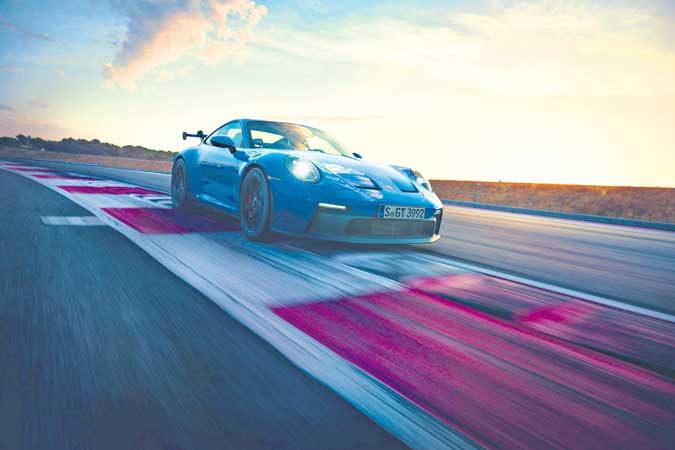Seven generations after first capturing the imagination, this Stuttgart-bred supercar still goes ‘natürlich angesaugt’
IN CASE you’re wondering, natürlich angesaugt is “naturally aspirated” in German. And, well, doesn’t it appear just a little more exotic when spelled out that way? And exotic is exactly the way we like it when we’re talking about the Porsche 911 GT3.
Now on its seventh generation, the much-desired, high-performance sports car from Porsche was launched online last week to a global media audience probably salivating in front of screens at home.
At first glance, particularly to those unacquainted, the newest iteration of this much-coveted vehicle might seem like a copy-and-paste affair. But while Porsche’s think tank certainly wants to keep that much loved, familiar look of the 911, there’s a whole slew of changes in the way the car is put together.
Simply put, the GT3 is the most “motorsports” cred you can get in a street-legal ride. That’s not to say this Porsche will not perform on a track. In fact, it burned through the iconic 20.8-kilometer Nürburgring’s Nordschleife proving ground at under seven minutes (6:59.927 to be exact) — taking 17 seconds less compared to its predecessor, and almost a full minute ahead of the first GT3 released in 1999.
What doesn’t change is the high-revving (to 9,000rpm), flat-six-cylinder, natürlich angesaugt (yes) boxer engine. And while you can drive this 911 to work or even to the mall for some grocery shopping (no rear seats though, sorry), make no mistake: This is a legitimate track weapon.
Powering the GT3 is a 4.0-liter engine thumping out 510ps (plus 10ps over its outgoing version) and 470Nm (plus 10Nm). It attains a top speed of 320kph (318kph with PDK), accelerating from standstill to 100kph in 3.4 ticks. And purists will be happy to note that the GT3 is also being offered with an old-school six-speed manual transmission.
Porsche sticks in an intake system comprised of six-barrel throttle valves straight from its track application. “Despite having two gasoline particulate filters, the lightweight sports exhaust system weighs less than the one fitted to the previous GT3,” said the company in a release.
There’s the rub, actually. Despite the slew of changes and improvements, the GT3 weighs more or less the same. And while keeping the weighing scale unperturbed, the quixotic exotic incorporates new technology, said Porsche Director for the GT Product Line Andreas Preuninger. Inside, the car gets more “edgy” yet “supportive” seats (covered in microfiber cloth) — doubtless to accommodate the more dynamic performance. Four-way sport seats are standard; 18-way sport seats and carbon fiber bucket seats (26 pounds lighter) are available as an option.
“This has been the most demanding GT project so far,” he declared. “This is the most extreme, most exciting GT3 we’ve ever developed.”
Weight-shaving was also realized in the judicious use of the right materials and parts — from lightweight glass in all the windows, to a stainless steel sports exhaust system and brake discs, through to the LiFePO4 starter battery. “The battery alone weighs 10 kg less than that in the previous 911 GT3. The result is that its power-to-weight ratio of 2.8 kg/ps for the manual-gearbox car is now even closer to the level of a thoroughbred race car,” reported Porsche. “Lightweight trickery,” underscored Mr. Preuninger.
Porsche’s engineers and designers waved their magic wands to trim weight without sacrificing on substance. The hood is made of carbon fiber, said the executive, as with the roof, rear wing, and even cross members.
To come up with a car that is truly better suited to the track than more pedestrian purposes, Porsche Vice-President for the 911/718 Mode Lines Dr. Frank-Steffen Walliser admitted that the company had to keep a balance between a street car and race car, pushing the “boundaries of homologation” in the development of the GT3. The winding road and the racetrack is where the car is most at home.
During the live question-and-answer portion, my question was fortunately chosen to be answered by the expert panel. I had asked how a car like the GT3 fit into the electrification plans of Porsche.
Dr. Frank-Steffen Walliser replied, “From my perspective, it still fits because it’s still the DNA of Porsche and we want to keep the DNA. Second is we published that we are doing our research and we have partners to look in the subject of synthetic fuels. What we see is something that could definitely reduce CO2 emissions worldwide, especially for the existing fleet. We want to test this in motorsport and it also fits the GT3. We have no downside by using this kind of fuel. That shows clearly that we trust in this technology.”
And we should perhaps also trust in Porsche to keep us at the edge of our seats waiting for the next exciting vehicle to come out of Stuttgart. Ja.




